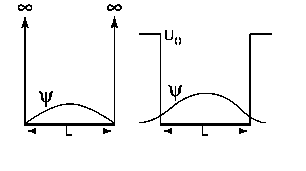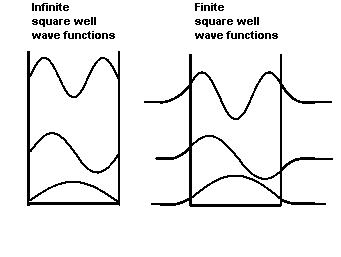

The classically forbidden region
The stationary-state wave functions for a particle in an infinite square well are some of the simplest solutions of the one-dimensional Schroedinger equation. In general, if U(x) does not go to infinity at x = 0 and x = L. Then the wave function extends to infinity, across discontinuities in the potential energy function U(x). The Schroedinger equation requires that the wave functions are smooth functions over the region from x = -∞ to x = +∞. Each wave function and its derivative with respect to x (its slope) must be continuous at all positions x. The derivative is only allowed to be discontinuous at x if U(x) = -∞ or +∞.
The time-independent Schroedinger equation
(-ħ2/(2m))∂2ψ(x)/∂x2
+ U(x)ψ(x)
= Eψ(x),
or
∂2ψ(x)/∂x2
+ (k12 - k0(x)2)ψ(x) =
0,
with k12 = 2mE/ħ2 and
k0(x)2 = 2mU(x)/ħ2
also has solutions in regions where the total energy E = KE + U(x) is less than
the potential energy U(x). Classically a particle cannot penetrate such a
region, because its kinetic energy KE in that region would be negative, which is
not possible.
Let us define α(x)2 = (k0(x)2
- k12) = (2m/ħ2
)(U(x) - E).
For a classically forbidden region
α2
is a real, positive number. In this region the time-independent
Schroedinger equation may be written as
∂2ψ(x)/∂x2 - α(x)2ψ(x) = 0.
Possible wave functions for the particle must satisfy this equation. If in some region a is constant, independent of x, then real solutions to this equation are
ψ(x) = A exp(αx) and ψ(x) = B exp(-αx),
with A and B arbitrary constants. The most general solution is a linear combination of these two solutions.
The finite square well
Consider a square well with walls that are not infinitely high. Put the origin the coordinate system at the center of the well and assume
U(x) = U0 for x < -L/2
U(x) = 0 for -L/2 < x < L/2
U(x) = U0 for L/2 < x.
We choose a potential that is symmetric about the origin because for a symmetric 1D potential the the energy eigenfunctions are always symmetric or anti-symmetric about the origin. We say that the eigenfunctions have even or odd parity.
How does the finite height of the walls affect the lowest lying
eigenfunctions? In the region from x = -L/2 to x = L/2 the potential energy U(x) = 0, and therefore k0(x)
= 0 and k2 = k12. Possible wave functions for the particle
still satisfy the
equation ∂2ψ(x)/∂x2
+ k2ψ(x) = 0, and solutions are of
the form ψ(x) = Acos(kx) (even) or ψ(x) =
Bsin(kx) (odd).
However, since the potential does not go to infinity at the walls, the
derivative
∂ψ(x)/∂x
must be continuous at |x| = L/2. ψ(x) cannot
abruptly drop to zero at the walls, it must go over smoothly into a function
which is a solution to Schrödinger's equation inside the wall. These solutions
are ψ(x) = A exp(αx)
and ψ(x) = B exp(-αx).
The wave function also cannot blow up at infinity, because we must be able to
normalize it. Therefore in the region x < -L/2 only the solution ψ(x) =
A exp(αx) is acceptable and in the region L/2 < x
only the solution ψ(x) = B exp(-αx)
is acceptable.
To find the allowed values of E we require that the wave function and its derivative are continuous at x = L/2 and x = -L/2.
ψinside(L/2) =
ψoutside((L/2), ψinside(-L/2) =
ψoutside(-L/2),
∂ψinside/∂x|L/2 =
∂ψoutside/∂x|L/2,
∂ψinside/∂x|-L/2 =
∂ψoutside/∂x|-L/2.
In the figures below we we compare the shape of the ground-state and excited-state wave functions of the infinite and the finite square well.


How do the energies eigenvalues compare?
Example:
For an electron in an infinite 0.1 nm wide square well the ground state energy is 37.6 eV.
For an electron in an finite 0.1 nm wide square well and height 1 MeV the ground state energy is 37.31 eV.
For an electron in an finite 0.1 nm wide square well and height 1000 eV the ground state energy is 29.67 eV.
There are infinitely many bound states in an infinite square well. There are a finite number of bound states in an finite square well.
In-class activity: Exploring bound states in potential wells
In laboratory 4 we will solve the one-dimensional, time-independent Schroedinger equation numerically and find the energy eigenvalues of an electron trapped in wells of various shapes.
Traveling wave packets
A particle in an well does not have to be in an eigenstate of the energy operator, it can be in a superposition of eigenstates. The probability density then is not stationary, but time-dependent. If the well is finite, i.e. the potential does not go to infinity at the edges, then the particle can have enough energy to escape the well and not be confined. Traveling wave packets, i.e. wave packets not confined to a well, are also not stationary states but superpositions of energy eigenstates. They are solutions of the time-dependent Schroedinger equation
(-ħ2/(2m))∂2ψ(x,t)/∂x2 + U(x)ψ(x,t) = iħ∂ψ(x,t)/∂t.
The applets linked below show some possible solutions of this equation
for different potential energy functions U(x). You can explore the
behavior of wave packets in one-dimension for various forms of the potential
energy function U(x).
Link: Solutions to the one-dimensional Schroedinger equation for various potential energy functions